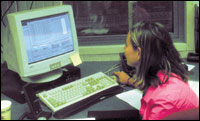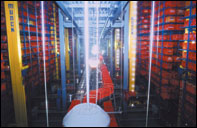Tech Update:
Plant Maintenance's Goldilocks Principle


The 800,000 cubic foot facility virtually eliminates manual product handling from the time cases of milk and juice arrive from the dairy's fillers until they reach the loading dock where trucks will take orders to Wawa's 520 convenience stores in the mid-Atlantic region. Sixteen storage/retrieval machines (SRMs) pick the daily orders on a first in, first out basis from the four-story high storage racks, accurately filling 99.98 percent of those orders.
The physical aspects of the AS/RS are impressive: 42-ft. tall SRM cranes pick and place from storage racks holding up to 82,000 cases of product. Eleven stackers and destackers handle cases as they move on the 5,500 linear feet of conveyors that snake through the DC. But the heart and soul of the system is the proprietary material handling control system (MHCS) that drives the equipment. Real-time condition reports on every motor, drive and operator interface help minimize the potential for unscheduled downtime.
But despite the sophistication of the system, it lacks a computerized maintenance management system (CMMS). Without CMMS, a plant or warehouse either performs too little or too much maintenance. With CMMS, plant engineers can instead perform maintenance tasks at intervals that are just right to avoid unscheduled downtime and work stoppages.
Also known as asset management software, a CMMS is basically a database program. Prominent examples are Rockwell Automation's RSBizware and Wonderware's Avantis.Pro, either of which can help refine and automate the demands of equipment maintenance. These CMMS packages provide a centralized point for collecting records and pertinent information about every processing, conveying and packaging machine in a plant. Failure histories, parts lists, bid prices, automatic generation of work orders for scheduled maintenance and other data reside in the central database. Over time, performance data can help a plant move away from repairing machines on an as-needed basis and toward a preventive or even predictive maintenance routine.
CMMS's Achilles heel, however, is its reliance on accurate and consistent recording of events. Were the symptoms and causes of a piece of equipment's failure known, and were the corrective actions recorded? "As with any database, it's a matter of garbage in, garbage out," allows Lyle Miller, a manufacturing solutions expert with Rockwell Automation. "It's got to be an extension of the maintenance team's day-to-day routine if it's going to work." It also needs to be tied to electronic procurement programs and business systems that track key performance indicators, Miller adds.
Automatic requests for quotes and reports on equipment activity are among the expanded functions recently added to Wonderware's program, but application consultant Annette Knoflach concedes that, as with any database program, the primary user benefit with Avantis.Pro is easy access to centralized data. Bells and whistles like web page links and HMI interfaces that display all work orders, labor and parts costs and other information when a machine fault is detected are all well and good, but unless information is accurately recorded in the first place, those features are useless.

Diagnostics without prediction
The system installed at Wawa is providing some support for the warehouse's preventive maintenance program, according to Over, but information collected by PLCs currently isn't being downloaded to a CMMS."It doesn't have a predictive or preventive function, but it does have a significant diagnostic capability," explains Michael Blouch, principal of Lebanon, Pa.-based Project Planners and Integrators. Blouch spent five years on the Wawa project, the last 19 months on site fine-tuning the AS/RS's DeviceNet system to handle peak-period demands for incoming inventory and outgoing orders.
At the front end, a 60-second shutdown in destacking cases is enough to back up conveyors to the dairy's fillers, forcing a shutdown in production. At the shipping dock, workers have 20 minutes to load each truck that will deliver that day's orders to the more than 500 convenience stores served by Wawa. A hiccup in the system can send ripples that affect the entire warehouse, and Wawa has a staff of 16 mechanics plus a maintenance supervisor and manager to make sure that minor glitches don't escalate into major disruptions.
More than 500 smart devices monitor machine performance and feed data back to the warehouse's control room. The voltage and current running through a motor and its thermal characteristics are measured, for example -- not simply whether the motor is on or off. When these signs of aging or wear exceed acceptable parameters, alarms are triggered, prompting a maintenance call.
"Fault sensors are present, so when a motor shuts off, the system tells you why it faulted," Blouch says. "That level of sophistication usually doesn't exist. When a fault occurs, you typically have to send an electrician and maintenance guy, and they have to trace the problem. Is it mechanical? Electrical? Thermal? That takes time, and the AS/RS was designed to run at a constant speed. If it takes a minute to respond to a fault, there is quite a bit of lost production."
Quick response to faults resolves the immediate problem, but recording the source of the fault and the corrective action taken is essential if managers are to refine their approach to maintenance management. "If you keep this system tuned, it delivers for you," notes Wawa's Over, and management is developing the database that will refine maintenance procedures into a preventive and, eventually, a predictive routine.
Patience, patience
The warehouse is believed to be the first mini-load AS/RS in the U.S. dairy industry. It's also the first North American refrigerated warehouse developed by Swisslog, a European firm that has purchased several domestic software and equipment companies in recent years, including Newport News, Va.-based Munck Automation Technology, the original designer of the Wawa system.A highly automated, flexible system was required, and that meant devising a solution more refined than the typical AS/RS, which picks pallets. Wawa wanted a system that could pick single cases or even single units. It also had to accomplish that at speeds of up to 45 outbound cases per minute. Meeting average pick speeds from the racks to the loading dock was no problem, Blouch recalls, but "that last 10 to 15 percent took 90 percent of the effort. We were in uncharted territory."
More than a year elapsed before a phased rollout of the new AS/RS began. Blouch credits the resolve of Swisslog and Dairy Conveyor Corp. for sticking with the project through its completion. Wawa was essentially a beta site for the MHCS. The effort already is paying off for Swisslog, which recently won a contract to build an automated refrigerated DC in Houston for Wal-Mart, the first of 26 planned by the retailer.
The Wawa warehouse includes a room-temperature ground floor and mezzanine level sandwiching the 38 F degree storage area. That posed some vapor-barrier challenges, according to Joe Shaffer, principal of Facilities Design Inc., the A/E firm for the project. The real-time inventory reporting that the system provides is an unusual feature, he adds.
Another is the eight load-out doors on the shipping dock. The doors are paired to four serpentine conveyors for loading. While one truck is being loaded, a second unloads its empty cases into the ground-floor case washer and is sanitized while parked at the dock. The second truck then is loaded, without the yard jockeying that typically occurs, Shaffer says.
In Wawa's old warehouse, product was manually handled four times, with errors occurring about once every 12 orders. Now, scanners read the date, product and lot information from bar codes as the six-high stacks of cases roll in, and the system automatically assigns each case a slot in the warehouse and rotates the inventory when picking orders. The pick system is integrated with two store-order packages and a transportation software program to maximize the staging process.
As many as 14 staff positions have been eliminated, says Over, with attrition and retraining short-circuiting the need for layoffs so far. The only manual operations remaining are the dragging of cases onto the trucks into predetermined loading diagram spots and single-unit picking for wholesale customers. Bulk loading of gallon containers has been eliminated, saving time and slashing overtime for route deliverymen.
Wawa expects it get a return on its AS/RS investment in five years, making it one of the more valuable corporate assets. Gradual migration to a CMMS is one way management can ensure that the investment keeps paying a dividend for years to come.

Sidebar:
Why PM software sometimes fails
Buying maintenance management software is one thing. Building the database that feeds the program is quite another, and that's where the wheels on computerized maintenance systems can fall off.Maintenance programs come in a variety of price points and sophistication levels, but essentially the software is an information engine. The fuel that feeds the engine is the maintenance schedules, parts lists, vendor contacts and other data relating to a plant maintenance program. Loading all that data into the software program can be a costly, time-consuming, tedious task, and more than a few maintenance supervisors have thrown in the towel before completing the job, leaving them with systems that aren't all they could be.
"Preventive maintenance systems are invaluable tools in maintaining the productivity of a plant," according to Robert White, president of Bakery Innovative Technology (bit) Corp. "It costs six times as much to keep a plant up and running without PMs because then you're just doing fire-station maintenance. But a lot of people never get beyond the spare-parts ordering function with their software system because they never entered the necessary data."
People who actually understand the machines' maintenance needs must key in data, he points out, and that can take more than six months and cost $50,000 at a mid-sized food plant. That's why White has spent the last six years developing a library of standard maintenance tasks and parts lists for a wide number of food processing machines. Based on his clients' actual PMs, the library can be modified to fit the user's routine, "but at least you're not typing word after word about standard tasks," he says.
Most of White's clients are commercial bakeries, so his enhanced COGZ maintenance management software is particularly well suited for those plants. But many of the same mixers, compressors, conveyors and cooling equipment can be found at most types of food operations, and plant engineers at those plants could save time with such a tool, he says.
Looking for a reprint of this article?
From high-res PDFs to custom plaques, order your copy today!


